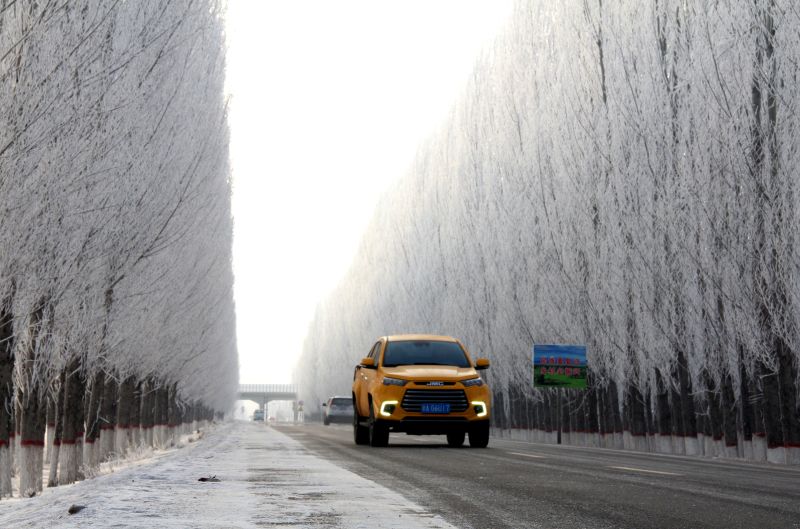
Extreme Winter Weather Forecast for Central and Eastern China

A forecast of heavy snow and rain is set to disrupt travel plans for millions of Chinese workers heading home for the Lunar New Year, posing significant risks and challenges to transportation.
The Impact of Extreme Winter Weather
Central and eastern China are bracing for an onslaught of heavy snow and rain, creating a formidable challenge for the millions of Chinese workers set to embark on their Lunar New Year journey back home. The Spring Festival, a revered holiday in China, typically witnesses a mass exodus of migrant workers as they make their way back to their families via trains, planes, and buses. However, the forecast for extreme winter weather has cast a shadow over these travel plans, raising concerns about potential disruptions and safety risks.
Frost lines the side of a road in China's far western Xinjiang region.
According to state broadcaster CCTV, the impending weather conditions are anticipated to be the 'most complex weather' since the heavy snowfall of early 2008, which affected over 67 million people. This rare weather event, characterized by its intensity and far-reaching impacts, has prompted warnings from forecasters and experts about the challenges it poses to safe travel and transportation. While the forecasted snowfall may not surpass the severity and coverage of the 2008 holiday season, it remains a cause for significant concern due to its extreme nature.
The affected provinces, including Hebei, Henan, Shandong, Liaoning, and Hubei, are preparing for blizzards and freezing rain in the lead-up to the Lunar New Year, creating a precarious situation for travelers and transportation systems. The Central Meteorological Observatory has issued a blizzard warning for the affected regions, with snowfall expected to reach up to 5 centimeters (nearly 2 inches) in some areas. In light of these forecasts, authorities have already taken precautionary measures, such as canceling high-speed train services and implementing reduced operating speeds to mitigate the impact of the impending blizzards and rain.
Challenges Posed by Freezing Rain
In addition to the forecasted blizzards, several provinces, including Henan, Hubei, and Anhui, are bracing for the impact of freezing rain, further complicating the travel landscape. Freezing rain, a weather phenomenon characterized by raindrops freezing into ice droplets upon contact with surfaces, has the potential to cause widespread damage and pose significant hazards for travelers. The China Meteorological Administration has issued warnings about the risks associated with freezing rain, including the potential damage to electricity cables and the increased risk of slippery roads. With the possibility of freezing rain affecting an extensive area spanning 43,000 square kilometers (16,600 square miles), the challenges posed by this weather phenomenon are substantial and far-reaching.
The memory of the blizzards that struck China in early 2008, resulting in power line damage and transportation disruptions, serves as a stark reminder of the destructive potential of extreme winter weather. The previous blizzards led to tragic consequences, with fatalities and the evacuation of hundreds of thousands of individuals in affected provinces. As the threat of freezing rain looms over multiple provinces, the need for heightened vigilance and precautionary measures becomes increasingly urgent in anticipation of potential disruptions and safety risks.
Historical Trends and Climate Extremes
China has experienced a series of extreme weather events in recent years, underscoring the growing impact of climate variability on the nation. From record-breaking low temperatures to unprecedented heatwaves and heavy rainfall, the country has grappled with a range of climatic challenges. The lowest ever temperature, recorded in Jintao town in Mohe, northeastern Heilongjiang province, plummeted to a staggering -53° C in January of last year, highlighting the severity of the winter conditions that can afflict the region.
Conversely, last summer saw China sweltering through its hottest year on record, accompanied by the heaviest rainfall in decades. The resultant flooding and extensive damage underscore the far-reaching consequences of extreme weather events, both in terms of human impact and economic costs. As the frequency and intensity of such events continue to rise, the imperative for proactive measures and adaptation strategies to mitigate the impact of climate extremes becomes increasingly apparent. The need for robust infrastructure, disaster preparedness, and climate resilience measures is underscored by the recurring challenges posed by extreme weather, emphasizing the importance of long-term climate action and mitigation efforts.









